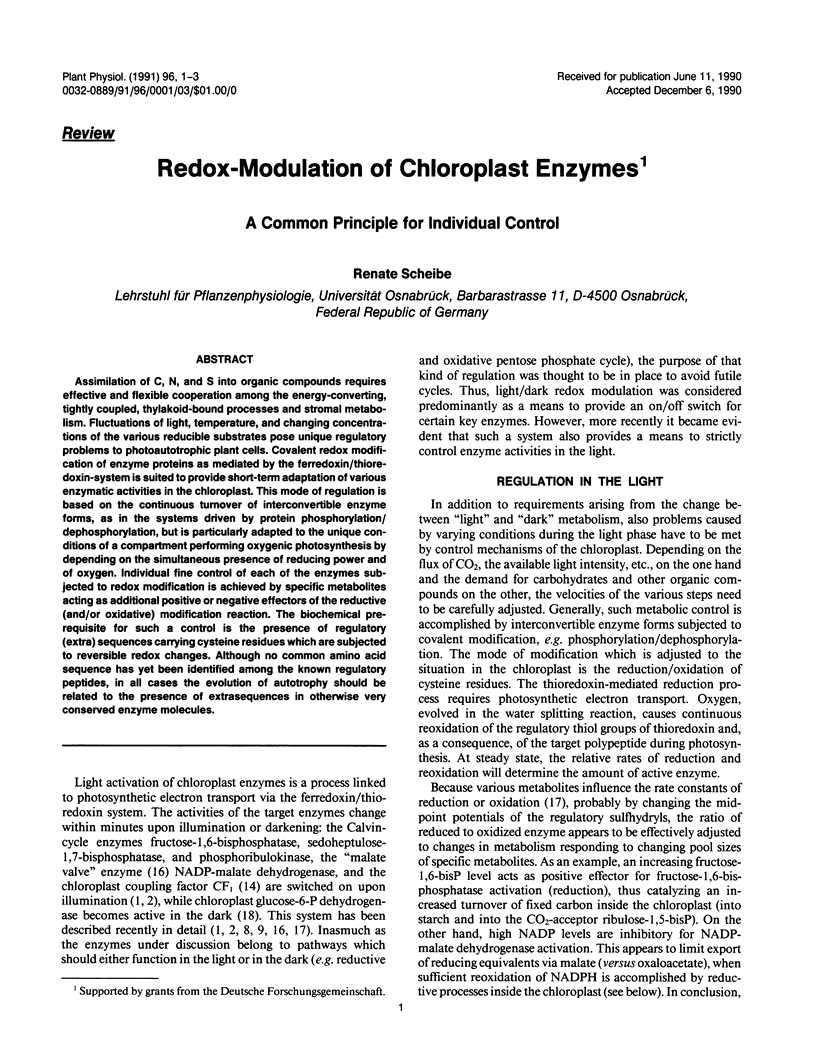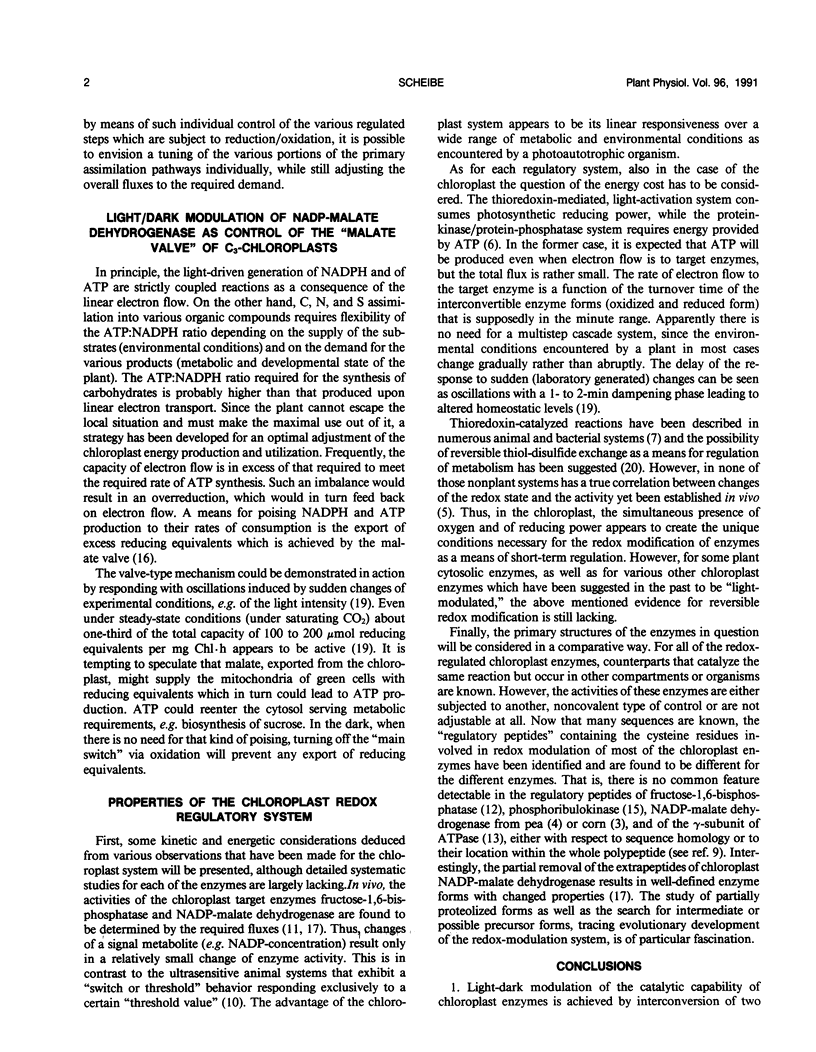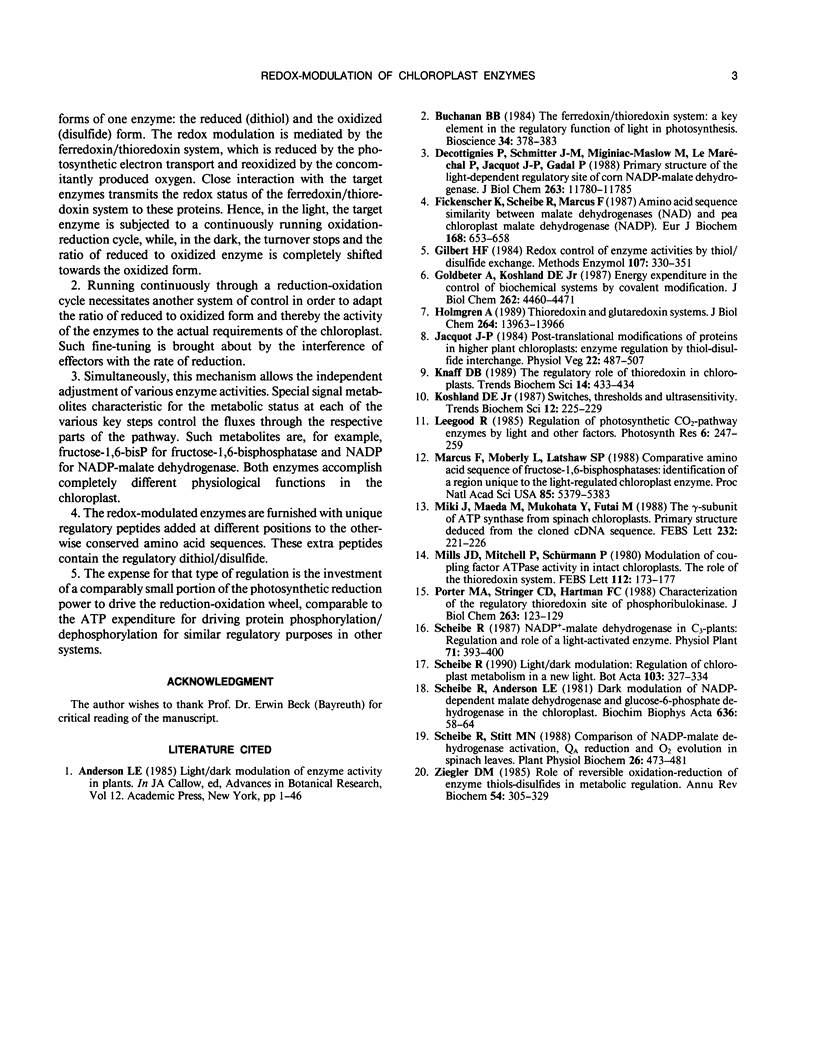Abstract
Assimilation of C, N, and S into organic compounds requires effective and flexible cooperation among the energy-converting, tightly coupled, thylakoid-bound processes and stromal metabolism. Fluctuations of light, temperature, and changing concentrations of the various reducible substrates pose unique regulatory problems to photoautotrophic plant cells. Covalent redox modification of enzyme proteins as mediated by the ferredoxin/thiore-doxin-system is suited to provide short-term adaptation of various enzymatic activities in the chloroplast. This mode of regulation is based on the continuous turnover of interconvertible enzyme forms, as in the systems driven by protein phosphorylation/dephosphorylation, but is particularly adapted to the unique conditions of a compartment performing oxygenic photosynthesis by depending on the simultaneous presence of reducing power and of oxygen. Individual fine control of each of the enzymes subjected to redox modification is achieved by specific metabolites acting as additional positive or negative effectors of the reductive (and/or oxidative) modification reaction. The biochemical prerequisite for such a control is the presence of regulatory (extra) sequences carrying cysteine residues which are subjected to reversible redox changes. Although no common amino acid sequence has yet been identified among the known regulatory peptides, in all cases the evolution of autotrophy should be related to the presence of extrasequences in otherwise very conserved enzyme molecules.
Full text
PDF


Selected References
These references are in PubMed. This may not be the complete list of references from this article.
- Buchanan B. B. The ferredoxin/thioredoxin system: a key element in the regulatory function of light in photosynthesis. Bioscience. 1984 Jun;34(6):378–383. [PubMed] [Google Scholar]
- Decottignies P., Schmitter J. M., Miginiac-Maslow M., Le Maréchal P., Jacquot J. P., Gadal P. Primary structure of the light-dependent regulatory site of corn NADP-malate dehydrogenase. J Biol Chem. 1988 Aug 25;263(24):11780–11785. [PubMed] [Google Scholar]
- Fickenscher K., Scheibe R., Marcus F. Amino acid sequence similarity between malate dehydrogenases (NAD) and pea chloroplast malate dehydrogenase (NADP). Eur J Biochem. 1987 Nov 2;168(3):653–658. doi: 10.1111/j.1432-1033.1987.tb13466.x. [DOI] [PubMed] [Google Scholar]
- Gilbert H. F. Redox control of enzyme activities by thiol/disulfide exchange. Methods Enzymol. 1984;107:330–351. doi: 10.1016/0076-6879(84)07022-1. [DOI] [PubMed] [Google Scholar]
- Goldbeter A., Koshland D. E., Jr Energy expenditure in the control of biochemical systems by covalent modification. J Biol Chem. 1987 Apr 5;262(10):4460–4471. [PubMed] [Google Scholar]
- Holmgren A. Thioredoxin and glutaredoxin systems. J Biol Chem. 1989 Aug 25;264(24):13963–13966. [PubMed] [Google Scholar]
- Knaff D. B. The regulatory role of thioredoxin in chloroplasts. Trends Biochem Sci. 1989 Nov;14(11):433–434. doi: 10.1016/0968-0004(89)90095-9. [DOI] [PubMed] [Google Scholar]
- Marcus F., Moberly L., Latshaw S. P. Comparative amino acid sequence of fructose-1,6-bisphosphatases: identification of a region unique to the light-regulated chloroplast enzyme. Proc Natl Acad Sci U S A. 1988 Aug;85(15):5379–5383. doi: 10.1073/pnas.85.15.5379. [DOI] [PMC free article] [PubMed] [Google Scholar]
- Miki J., Maeda M., Mukohata Y., Futai M. The gamma-subunit of ATP synthase from spinach chloroplasts. Primary structure deduced from the cloned cDNA sequence. FEBS Lett. 1988 May 9;232(1):221–226. doi: 10.1016/0014-5793(88)80421-6. [DOI] [PubMed] [Google Scholar]
- Porter M. A., Stringer C. D., Hartman F. C. Characterization of the regulatory thioredoxin site of phosphoribulokinase. J Biol Chem. 1988 Jan 5;263(1):123–129. [PubMed] [Google Scholar]
- Scheibe R., Anderson L. E. Dark modulation of NADP-dependent malate dehydrogenase and glucose-6-phosphate dehydrogenase in the chloroplast. Biochim Biophys Acta. 1981 Jun 12;636(1):58–64. doi: 10.1016/0005-2728(81)90075-x. [DOI] [PubMed] [Google Scholar]
- Ziegler D. M. Role of reversible oxidation-reduction of enzyme thiols-disulfides in metabolic regulation. Annu Rev Biochem. 1985;54:305–329. doi: 10.1146/annurev.bi.54.070185.001513. [DOI] [PubMed] [Google Scholar]


